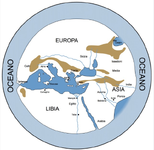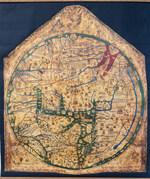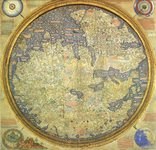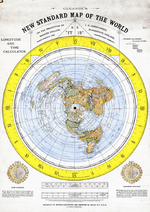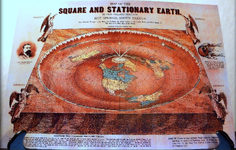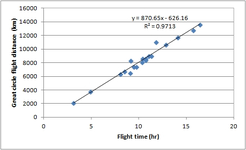All of these "proofs" are junk, this guy doesn't understand what inertia is. If I'm in a car moving at 60 mph and throw a ball up in the air, the ball lands right back in my hands. It doesn't go flying off or hit my face, because the ball is moving at 60 mph before I throw it. Likewise nothing would fly off a globe at a tangent because we're all moving on the same globe. This doesn't disprove anything about the globe.
Yes its true that throwing a ball up in a moving car and having it land back in your hands demonstrates the principle of inertia, however it's important to recognize the difference between linear motion and rotational motion. In the idea of the Earth spinning around an axis, we're not dealing with linear motion along a straight path, but rather with rotational motion around that axis.
The ball scenario is easily explained without anything related to Newtonian Mechanics. As the ball is thrown upward in the moving car, it encounters resistance from the air, which slows down its upward motion. However, the ball's density is greater than that of the air, so it tends to sink downward. Meanwhile, the car continues moving forward at a constant velocity. Due to its density, the ball gradually descends relative to the car's frame of reference, maintaining a path closer to the driver's hand. This downward motion is governed by the density differential between the ball and the surrounding air, rather than any gravitational force. Air behaves as a fluid due to its ability to flow and conform to its container, driven by differences in density and pressure gradients, and the behavior of objects in fluids of varying densities determines their trajectories, which we can apply to every object across the Earth.
The crucial distinction here is that the idea of the Earth's rotation involves a change in direction as well as speed. If the Earth were a spinning globe, objects on its surface would not only have the Earth's rotational speed but also experience a change in direction as they move along its curved surface. Imagine spinning a bucket of water around in a circle. I'm sure many of us did this as kids at some point. The water stays in the bucket because it's contained by the bucket's walls, preventing it from flying off tangentially. Similarly, if the Earth were spinning on an axis, there would need to be a physical mechanism holding everything in place against the centrifugal force pulling objects away from the axis of rotation. We can talk about gravity here but that's a moot point because they have no provable explanation for it outside of theoretical models.
So basically this first point made by Ebenezer Breach is that without a physical axis for the Earth's rotation, being a solid body upon which objects can revolve, the concept of rotational motion becomes purely theoretical and lacks a tangible basis in physical reality.
These vids are also junk, the horizon is way further out than a mere 30 miles.
Depends on where you are. According to the mathematics of the estimated globe measurement, if you are at sea level, the horizon is roughly 3 miles out. So while our eyes cannot distinguish what is at the wave line at 3 miles out, the Nikon cameras should not be able to either from a perspective of roughly 2 meters above sea level, nor should they be able to zoom in on boats past the convergence of perspective lines at the vanishing point. These cameras have a zoom feature of 125x compared to Galileo's telescope of 20x. If you are at 30,000 feet the horizon is 170 nautical miles calculated to 195 miles. I've seen geographic features a lot further than that at a lot lower than 30,000 feet.
Here is an example of a mathematical model for this phenomena, albeit it not being a universal absolute:
https://sites.math.washington.edu/~conroy/m120-general/horizon.pdf
I do not believe that because the math can be proven wrong, logic dictates that the globe is immediately wrong. But it begets the question, what are we dealing with? I believe that we must take on an entire higher subject of luminaries, celestial phenomena, electromagnetic fields, and an in-depth analysis of Newtonian Mechanics and Copernican models to come anywhere near that assessment.
The formulas are not infallible, which is why I refuse to side completely with both model's proponents and push for more exploration and proof done by those with an open mind and not an agenda. The purpose is not to prove one's model true, sure we can have a hypothesis, but it should be to undertake a measurement of truth. So much of the globe model is based on extra-terrestrial criteria that we do not have any objective way of measuring. Nothing is really being accomplished or proven.
This is bad post here, and anyone who liked it doesn't grasp physics. I don't need to read anything beyond this because the premises are wrong.
I acknowledge that Newtonian physics is a theoretical framework, and by doing so I invite a broader discussion about different perspectives and interpretations of physical phenomena. There is nothing wrong with encouraging critical thinking and openness to exploring alternative explanations, including those that may challenge supposed conventional scientific paradigms. That is what a forum was historically used for.
However, I won't be insulting anyone's knowledge of physics or lack thereof (if it's garbage in, it's garbage out, and better without), but I would ask you to read each of Ebenezer Breach's twenty points and consider the context of the era and what the educational system was like during those years before making an automatic bias. A complete judging without a full examination is the pinnacle of nescience, and I know you are both intelligent and discerning. I also know most people don't have time for essays, but I do appreciate a reciprocal debate from anyone.
I notice, no one here has responded to the video of the guy in Antarctica with a compass, which I posted a few pages ago.
I have to make an effort to reply to everyone who posts here because of how much interest I have in this subject.
@Wutang @RedLagoon @KomnenAl @Cooper
I know you all are tired of me, but I promise the rest of this lengthy post is worth it.
Here we can see a guy using a compass in the South Pole, and it points down into itself (which means it's pointing to the North Pole at the other end of the planet, through the crust). No more denying reality or there will be bans.
I have met several people who have traveled to Antarctica from airports in southern Oceania as part of weather monitoring teams working for government-subsidized research organizations, however their testimony of the time they spent there does not prove anything one way or the other. From what I know of people who have been to Antarctica, it's similar to most government/military TDY's, they stay in their area and then they leave when their rotation is done. There is very little personal exploration anywhere inland, mostly just someone pointing to a distant spot and saying "there is Ross Island," or some other geographical feature.
Most people who want to visit that do not get flown there for work have to pay anywhere from around $10,000 - 30,000 for a guided tour that takes them to places like Deception Island (go figure). These islands exist and are observable and touchable for all, but when it comes to the deeper treks inland it is virtually impossible to do this on one's own after the Antarctic Treaty was signed in 1959. There were plenty of earlier expeditions that did find questionable things of a different nature (not so much the edge of the world but rather ruins of alleged ancient civilizations among vast swathes of nothing). There have not been any recorded circumnavigations of Antarctica or a globular north-south path, likewise there is no record of any barrier beyond Antarctica. These kinds of boundary-verifying cosmological quests are bigger than most people could ever fathom given all that we do not know.
For the content of the video, this guy is too busy over there doing science™ to explain his compass completely, and though he does state correct observable phenomena with how its reacting, he does not understand the cause of it. I will do my best to make this briefer than usual:
True vs Magnetic north:
In our education, we are taught that true north is not the same as magnetic north. Most compasses have one needle which mainly points towards magnetic north. The compasses with two needles which the PolarTREC guy uses have a declination needle which accounts for the directional difference between the two alleged "poles," true north and magnetic north. He notes that the magnetic "south pole" is in the ocean and not even on Antarctica, yet the concept of the geographic south pole is an internally agreed-upon location surrounded with the flags of the countries who signed the treaty. This is what we believe based on the theory of magnetic fields of the earth.
Magnetic fields:
The conceptions for earth's ground-based magnetic field has a shaky foundation as they are also built from abstract models like the geocentric dynamo theory, which, like all theories is still subject to ongoing research and refinement. We are told Earth's magnetic field is generated by these complex processes deep underground such as the movement of molten iron. If this is true, these processes produce fluctuations and anomalies in the magnetic field over time, but they do not necessarily imply a complete reversal or rapid shift of the magnetic poles, which is what the declination needle is implying to be used as a correctional navigation aid for. So even by mainstream science, there are issues with trusting these compasses for accurate readings at the poles because of this uncertainty about the magnetic fields source.
Number of poles:
With our current model it gives us four poles essentially, two true geographic locations and two magnetic centers based on the theory of shifting magnetic fields. The majority of flat earth proponents usually only offer a single pole model. The issue with this is that it does not take into account the rotation of the stars, which disproves both heliocentric earth and the Gleason flat earth conceptions of polarities and instead posits a bi-polar axis of rotation for the celestial bodies around Polaris (north) and Sigma Octantis (south). The arguments that everything is just "perspective" fall flat against the presence of these celestial proofs.
Directions and Polaris navigation:
Unlike the cardinal directions on a compass rose, north, south, east, and west on earth are not simply straight lines separated by 90 degrees. In the unipolar flat-earth model, north, rather than being an upward shooting arrow, is a center-point known as the geographic north pole, situated directly below Polaris, the North Pole Star, the star in the heavens which marks the exact northern center-point of the sky. South, rather than being a downward shooting arrow, is actually every line tangent to the northern center-point, or in other words, every straight line extending outwards from the north pole, hence, due south. East and West, rather than being right and left-facing arrows, are clockwise and counter-clockwise circles around the pole. In the real observable and accurate pattern of the two fixed stars of Polaris and Sigma Octantis, it is slightly different, and it debunks this particular model, but it does not prove heliocentrism nor globe earth.
North is still defined as the direction towards the North Pole, where Polaris, the North Star, is situated. This point acts as the central reference for the northern hemisphere. South, on the other hand, is now defined as the direction away from the southern celestial pole, which is marked by Sigma Octantis. This pole serves as the counterpart to Polaris in the southern celestial hemisphere. East and West are determined by the apparent rotation of the stars around the celestial poles. In the northern region, the stars appear to rotate counterclockwise around Polaris, defining the east-west axis of the heavens accordingly. In the southern regions, the stars appear to rotate clockwise around Sigma Octantis, leading to a different interpretation of east and west compared to the northern regions. Don't be confused by my usage of "hemisphere" here, it is more like a tunnel of stars that create the visual effect of being inside a circular entity, as I will show in the pictures below.
Navigators since ancient times have used Polaris to guide their ships, knowing that Polaris was the heavenly north pole, south meant traveling keeping your back to Polaris, east meant traveling keeping your left shoulder 90 degrees to the pole star, and west meant traveling keeping your right shoulder 90 degrees to the pole star. I will explain why they did not base their navigations on a southern pole below.
Octantis phenomena:
The contested southern pole Sigma Octantis lies within the Octans constellation. It is definitely nowhere near as bright as Polaris, in fact it is very faint, but there is a southern axis point, just as in the northern sky's boundary. The navigators of the exploration eras could not make it out in the still night sky, but we can today with different visual instruments. One of the remarkable similarities between the two is that they both exhibit lights, the northern lights are called the Aurora Borealis and the southern lights produced by the south pole are called the Aurora Australis. This conception of the firmament of the heavens renders itself as a circular entity that rotates on the two poles.
Magnetism in Celestials:
The magnetic field theory and celestial polarities serve different purposes and are not mutually exclusive. While we have yet to prove beyond a reasonable doubt the complete veracity of the geo-dynamo and molten core causing magnetism, there is complete proof that the two stars are fixed positions in the sky and the other stars rotate about them. This is why ancient civilizations constructed their cosmologies of the known universe as a level plane surface with an indistinguishable underworld of varying depictions inside of a rotating dome, or firmament, which can create the illusion of being on a sphere if the phenomena is inverted like it is in the heliocentric model.
Magnets have two poles, so understanding our cosmos within our limited knowledge of magnetism on a cosmic scale would yield currents going one direction in the north pole and the opposite direction in the south pole in the path of the stars as seen in time-lapses. Imagine interlocking clocks in the sky, with one cog turning clockwise and the other turning counter-clockwise, now put that side-by-side with the time lapse from the Equator side-by-side, and you see the dual vortices in motion together. From the equator, if you observe this phenomena, you just see it going over your head. If you face north from the equator, you will see Polaris with its clockwise spiral, and if you face south from the equator you will see Octantis with its counter-clockwise spiral (in time lapses):
North and south:

lateral:

The fixed positions of Polaris and Sigma Octantis relative to the observer's location are evident that they are anchored to celestial poles rather than being distant objects around a spinning Earth. There is also no detectable stellar parallax for Polaris and Sigma Octantis which corroborates that they are not distant objects but rather fixed points in the sky. If Polaris and Sigma Octantis were distant stars orbiting a spinning Earth, their positions in the sky would gradually change over time due to factors such as precession and the Earth's axial tilt according to the heliocentric model. However, historical astronomical records and observations have notated that these stars have remained fixed in their respective positions, suggesting that they are anchored to celestial poles rather than being subject to the alleged motion of Earth's rotation.
Both the Copernican heliocentric globe and the Cheeseburger with a frost-bitten perimeter model of flat earth that is provided by many who do not do proper research are fallacies compared to this originally antediluvian conception. The Gleason azimuthal equidistant map is basically a flattened globe, and this globe model is just a ball-wrapped Mercator. Both of these fallacies are based around the two-poled Mercator. The original Mercator map predates our modern heliocentric globe model, which was first produced in its current iteration by Englishman John Cary (the Cary terrestrial globe), the difference in their release was about two hundred and twenty years or so, from 1595 to 1815, give or take a year.
Celestial Poles vs. Magnetic Poles:
One has to understand how magnetism works on an illustrative scale, and then you can see that this behavior fits observable phenomena much more than either two models. Instead of the "magnetic" pole we are told is emanating from earth's magnetic fields which are not proven to exist beyond the theoretical stage, we have the geographic poles juxtaposed and the celestial poles taking the place of the magnetic poles:
The Geographic North Pole is the point on the Earth's surface where the axis of rotation intersects the northern hemisphere's celestial rotation. It serves as a geographical reference point for navigation and mapping.
The Geographic South Pole is similar, this is the point on the Earth's surface where the axis of rotation intersects the southern hemisphere's celestial rotation.
The Celestial North Pole is the fixed point in the sky directly above the Earth's geographic North Pole. It is marked by the star Polaris and serves as a reference point for celestial navigation in the northern regions.
The Celestial South Pole is the fixed point in the sky directly above the Earth's geographic South Pole. Although visibly Sigma Octantis is no bright star like Polaris, it still serves as the source of the rotation for the stars in this celestial hemisphere and a reference point for celestial navigation in the southern regions.
Celestial Rotation and Compass Reaction in Antarctica:
The apparent malfunction of the compass near Ross Island is not indicative of an issue with Earth's south magnetic pole but rather reflects the influence of celestial magnetic fields emanating from Sigma Octantis, the real south pole. While the compass may still point towards the magnetic north, which corresponds to Polaris in the sky, its erratic behavior near Ross Island can be attributed to the intense magnetic fields generated by Sigma Octantis and other celestial bodies in the southern celestial hemisphere.
Therefore, even in Antarctica, or the Arctic regions where the magnetic compasses still point towards the magnetic north (Polaris) and south (Octantis counterpart), their behavior is explained by the influence of the magnetic fields generated by these fixed celestial poles rather than any hypothetical magnetic field originating from the Earth's interior.
Declination needle explanation:
When using a compass in different locations on Earth, the declination needle adjusts its orientation based on the relative positions of the observer and the celestial poles (Polaris and Sigma Octantis). In the Northern regions where Polaris is the celestial pole, the declination needle aligns with the magnetic field generated by Polaris. Conversely in the southern regions where Sigma Octantis is the celestial pole, the declination needle aligns with the magnetic field generated by Sigma Octantis.
Simply because there are problems with the existing models of earth and space does not mean the Disk Earth model (i.e. Flat Earth) is correct. Quite the opposite and the contradicting evidence against flat models is overwhelming.
I have been saying this too.
The pro arguments basically say we must take the word of our institutions at face value even though there are inaccurate observable proofs based on a theoretical framework with more holes than a patchwork quilt, but everything functions so why question it, while the true con arguments basically say we must not and we must search for observable proof because there are enough inaccuracies in the presented theory to reckon a reanalysis. The issue with the impatient con argument, which is to jump immediately to "flat earth" without investigating all these histories, concepts, models, dialogues, and observations. With all the trouble we have to deal with these days, who has the time indeed? Just as the Desert Fathers contemplated many things in understanding God's laws for both man's daily life and that of our realm and how it would be interwoven with a future Christian civilization, we too must emulate this higher ideal of thought than the base desires our material society has presented us with, and that is why this discourse is truly important, along with many others of a similar nature.
There are absolutists in both camps who do not want people believing in anything but what their model represents. When it comes to conflict in ideas, there are flat earth proponents are guilty of attempting to argue with globe earthers just as much as the other is with them, and all this rhetorical back-and-forth gets the dialogue nowhere without looking beyond what we do not know. In the very least it should be a question, and an answer, a gentlemanly game of philosophical posits combined with measurable experiments set out to prove or disprove a contrary claim, and then growing from that result. There are people who do not believe in the globe who are doing the latter, but it is not widespread among dissenters yet. I encourage them to do more experiments, because it is how we have defined our reality historically, up until the recent woke times where all of this analysis of nature is thrown out. Cosmology certainly has the potential to be one of the highest spiritual topics of the day outside of Salvation and the Gospel, were it cleaned up a little bit. The arguments between the mainstream globe and the alt-mainstream flat models are becoming like democrats and republicans, except they hate each other for real.
The closer truth is always a synthesis of the dialectic. Starting with a thesis, reacted to by an antithesis, and the ensuing conflict generates a synthesis. It always proceeds in a step-ladder type chain reaction of the next antithesis to the first synthesis (which acts as the first thesis for the next round), followed by a second synthesis resolving that conflict, and so on. Aspects that were stitched to Copernicus' model are real observable and true, but unexplainable phenomena like a lack of curvature can be explained by a level plane surface are also evident. When you combine the truths of both together and discard the fallacies, a clearer picture emerges of something very different than either one, yet it is still incomplete. Why is this?
I must yield to Scripture even after all of this analysis and research that I have done, and so should everyone else. We cannot contain all of God's creation within a human-conceived model. What did God say to Job?
From the Masoretic Text: Job 38:4-7:
אֵיפֹה הָיִיתָ בְּיָסְדִי אֶרֶץ הַגֵּד אִם יָדַעְתָּ בִּינָה תַּגִּיד. מִי שָׂם מְמַדֶּיהָ כִּי תֵדָע אוֹ מִי טָּק עָלֶיהָ קָו. עַל מֶה אֲדָנֶיהָ יֻסַּדוּ אוֹ מִי הֵשִׂים אֶבֶן פִּנָּתָהּ. בְּהַרְאוֹתִי בָרֶקֶת בְּקֶרֶב הַיָּם וָאֶסְפֵּר עָלֶיהָ חֻקִּים. בְּעָז יָם אֶעֱצֹר וְאֶשְׂפֹּר עָבֵים בְּאוֹם יַעֲרָב. בְּמָה יָדַעְתָּ כִּי יַלִּיד וְאוֹ כִּי יָצוֹא חֹשֶׁךְ. מֵאֵיפֹה יִפָּרֵץ כַּרְעָב. וְאַרְץ דְּשָׁעָתָהּ מִי נָתַן יַלֶּקֶת. הַיָּלִיד לִשְׁלָאֹות כְּמוֹ תֹוצֵא חָדָשׁ אִילוּן רְחֹמֶיהָ.
Eifo hayita be-yasdei eretz; haged im yada'ta binah tagid. Mi sam memadeiha ki te'da o mi taq alaiha qav. Al meh adaneiha yussadu o mi hesim even pinatah. Be-harot'i ba-reket be-qerev ha-yam, va'esper aleiha chuqqim. Be-az yam e'etzor ve'espor avayim, be'om ya'arav. Be-mah yada'ta ki yalid ve'o ki yatsa choshekh. Me'eifo yiparets kar'av, ve'aretz deshaatah mi natan yaleqet. Ha-yalid li-shela'ot ke-mo totzei chadash iylun rechomeiha.
"Where were you when I laid the foundation of the earth? Tell me, if you have understanding. Who determined its measurements—surely you know! Or who stretched the line upon it? On what were its bases sunk, or who laid its cornerstone, when the morning stars sang together and all the sons of God shouted for joy? Or who shut in the sea with doors when it burst out from the womb, when I made clouds its garment and thick darkness its swaddling band, and prescribed limits for it and set bars and doors, and said, 'Thus far shall you come, and no farther, and here shall your proud waves be stayed'? Have you commanded the morning since your days began, and caused the dawn to know its place, that it might take hold of the skirts of the earth, and the wicked be shaken out of it?"
There is an implication in the book of Job that Job may have harbored a sense of pride or presumption in his understanding of God's ways. God appears in a whirlwind and challenges Job with a series of questions that highlight the limitations of human understanding compared to God's wisdom and power. God questions Job about his knowledge and involvement in the creation and ordering of the Earth, emphasizing the vastness and complexity of creation and the divine authority and sovereignty over it.
So for those of you who tout that the globe is a definite surety based on "centuries of worldly knowledge," the passage in Job 38 serves as a powerful indictment against the arrogance of those who assert the heliocentric model as an absolute truth. The same goes for charlatans hawking the unipolar flat earth and attempting to sell it. It challenges the hubris of claiming complete understanding of the cosmos and highlights the limitations of human knowledge. Job 38 demands humility in the face of creation's mysteries and admonishes against the false certainty of scientific dogma.
Since the heliocentric model specifically asserts that the sun is the center of our solar system with the Earth revolving around it. However, Job 38 reminds us that the mysteries of the movements of celestial bodies are beyond human comprehension. This again denies the unipolar flat earth model as well. It questions the arrogance of those who claim to have unlocked the secrets of the universe, urging us to acknowledge the limitations of our understanding.
Furthermore, Job 38 calls into question the notion of an Earth in motion, orbiting the sun at tremendous speeds. It challenges both the heliocentric model's assertion of a dynamic, constantly moving Earth, suggesting instead that the Earth may occupy a unique and stationary position in the cosmos, but does not reduce this creation to a singular clockwork disc with an unremarkable cosmos surrounding the way basic flat-earth proponents do.
Food for thought.


